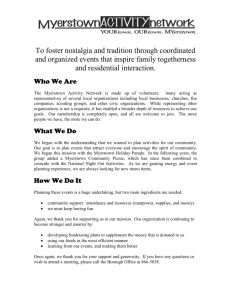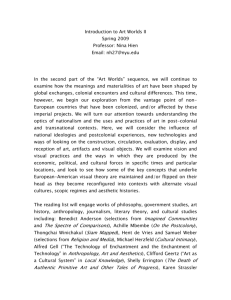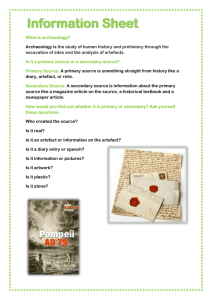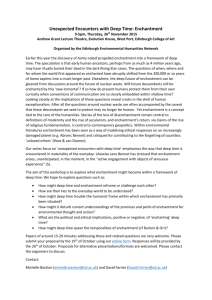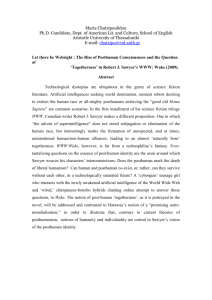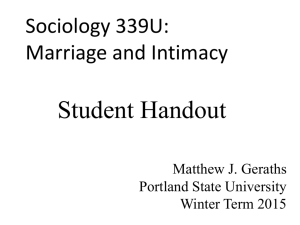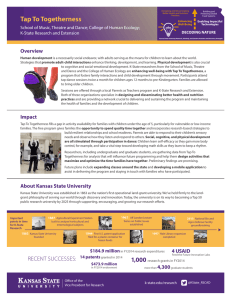Document 13118812
advertisement
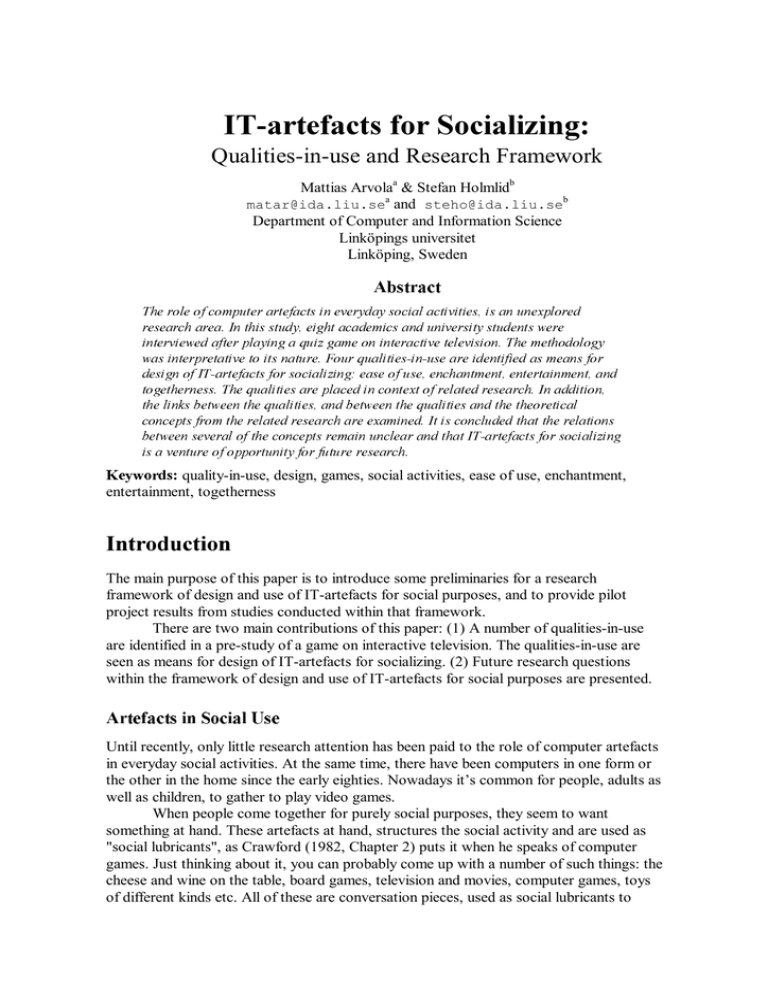
)4ARTEFACTS FOR 3OCIALIZING Qualities-in-use and Research Framework Mattias Arvolaa & Stefan Holmlidb a b matar@ida.liu.se and steho@ida.liu.se Department of Computer and Information Science Linköpings universitet Linköping, Sweden !BSTRACT 4HE ROLE OF COMPUTER ARTEFACTS IN EVERYDAY SOCIAL ACTIVITIES IS AN UNEXPLORED RESEARCH AREA )N THIS STUDY EIGHT ACADEMICS AND UNIVERSITY STUDENTS WERE INTERVIEWED AFTER PLAYING A QUIZ GAME ON INTERACTIVE TELEVISION 4HE METHODOLOGY WAS INTERPRETATIVE TO ITS NATURE &OUR QUALITIESINUSE ARE IDENTIFIED AS MEANS FOR DESIGN OF )4ARTEFACTS FOR SOCIALIZING EASE OF USE ENCHANTMENT ENTERTAINMENT AND TOGETHERNESS 4HE QUALITIES ARE PLACED IN CONTEXT OF RELATED RESEARCH )N ADDITION THE LINKS BETWEEN THE QUALITIES AND BETWEEN THE QUALITIES AND THE THEORETICAL CONCEPTS FROM THE RELATED RESEARCH ARE EXAMINED )T IS CONCLUDED THAT THE RELATIONS BETWEEN SEVERAL OF THE CONCEPTS REMAIN UNCLEAR AND THAT )4ARTEFACTS FOR SOCIALIZING IS A VENTURE OF OPPORTUNITY FOR FUTURE RESEARCH quality-in-use, design, games, social activities, ease of use, enchantment, entertainment, togetherness +EYWORDS )NTRODUCTION The main purpose of this paper is to introduce some preliminaries for a research framework of design and use of IT-artefacts for social purposes, and to provide pilot project results from studies conducted within that framework. There are two main contributions of this paper: (1) A number of qualities-in-use are identified in a pre-study of a game on interactive television. The qualities-in-use are seen as means for design of IT-artefacts for socializing. (2) Future research questions within the framework of design and use of IT-artefacts for social purposes are presented. !RTEFACTS IN 3OCIAL 5SE Until recently, only little research attention has been paid to the role of computer artefacts in everyday social activities. At the same time, there have been computers in one form or the other in the home since the early eighties. Nowadays it’s common for people, adults as well as children, to gather to play video games. When people come together for purely social purposes, they seem to want something at hand. These artefacts at hand, structures the social activity and are used as "social lubricants", as Crawford (1982, Chapter 2) puts it when he speaks of computer games. Just thinking about it, you can probably come up with a number of such things: the cheese and wine on the table, board games, television and movies, computer games, toys of different kinds etc. All of these are conversation pieces, used as social lubricants to gather people. Harris (1994) made an informal survey of role playing games and other entertainment where the participants are co-present. He found that they wanted mental and social stimulation; family and friends to be able to play together; experience travel adventures; experience thrilling but safe adventures; engage in mysteries, relationshipcentred simulations and explorations, such as participatory soap operas; and they wanted sensual and symbolic experiences. Löwgren and Stolterman (1998) describe two dimensions of artefacts intimately connected to games: motivation and playability. The motivation of the game is considered high if the players continue to play just for the sake of playing. The playability is high if it’s challenging, interesting, and fair; driven by fantasy and curiosity; has constant news value; and if the players have a sense of control and possibilities to compete against others. Holmquist (1997) has made an artefact study of a successful platform computer game and identified five components of a good game: it’s easy to learn; it rewards repeated gaming; it’s fair; it has its own laws of nature; and it has very precise control. Most of the studies mentioned above share the idea that the situation of gaming is social to its nature. They aim at defining the properties of gaming, or the qualities-in-use of a game. 1UALITYINUSE Asking oneself whether an IT-artefact is good or not, cannot be answered merely by studying the properties of the artefact in itself. Traditionally this has been the focus for HCI as well as for software quality. One step further is taken through the definition of quality-in-use in the ISO/IEC 14598-1 standard (Software product evaluation—General guide) (from Bevan 1997): ”QUALITY IN USE the extent to which a product used by specified users meets their needs to achieve specified goals with effectiveness, productivity and satisfaction in a specified context of use” In settings where shades of satisfaction are of more interest than effectiveness and productivity, the definition provided by ISO/IEC 14598-1 is too weak. It is specialised for tools and do not capture the holistic qualities-in-use. In an attempt to describe the use of IT-artefacts instead of the IT-artefacts themselves, Ehn and Löwgren (1997) proposes a model for assessment of quality-in-use consisting of three quality perspectives. In short they view quality-in-use as the combination of constructional qualities, functional or ethical qualities and formal or aesthetical qualities. They say (Ehn & Löwgren, 1997, p. 309): ”The STRUCTURE of a system is its material or medial aspects. [...] The FUNCTIONAL aspects of a system concerns its actual, contextual purpose and use. [...] the FORM of a system expresses the experience of using the system.” Elaborating on this Löwgren and Stolterman (1998) uses four quality perspectives; structural which denotes the construction of an IT-artefact, functional which denotes the working of the system for the specified users in the use context, ethical which denotes the wider effects of the use or misuse of the system, and aesthetical, which denotes the aesthetical experience of the system. For any of the models it is important to view the perspectives not as complementary but as perspectives of a whole—the use of a system (Holmlid, 1997). A design decision concerning structure should be considered not only from a structural perspective but also from, e.g., an aesthetical perspective. With artefacts for socialising and games it is necessary to use a broad model of quality-in-use. Thus, it is preferred to view quality-in-use as quality perspectives on the use of the IT-artefact. The difference in using Ehn and Löwgren or Löwgren and Stolterman for designing and assessing the quality of a design is minor. In this study Löwgren and Stolterman is used. 3ETTING A quiz game on interactive television was designed with the goal of maximising the social interaction: The opportunities for confrontation, deception and negotiation were to be emphasised. The game was built for two players competing against each other. A board was displayed on screen and the players moved the pieces and answered the multiplechoice questions with the remote control. The informants, who played the game and then were interviewed, were invited to the offices of Nokia Multimedia Terminals in Linköping, Sweden. They played the game in pairs in a kitchen while having a cup of coffee and some cookies. The people in the pairs were friends, four women and four men, between 21 and 30 years old. All were university students or academics. The initial purpose of the study was to investigate a novel way of providing feedback in applications with several users in front of the screen (see Arvola, 1999). Additional empirical material about the general experience of playing the game and what was good and bad about it was, however, collected during the interviews. Here the focus is on the latter material. -ETHODOLOGY The study was conducted as an interpretative case study. Klein and Myers (1999) state that research is interpretative when the understanding of human sense making is gained through the study of social constructions (for example: language, shared meanings, consciousness, artefacts etc.) as a situation emerges. The study performed here is not ethnographic to its nature since the time spent on participant observation was small, instead it relies on interviews as its main source of empirical material. During the interviews, field notes were taken, and as an initial analysis they were examined with the following questions in mind: What do the informants say about the activity of playing the game? What are the qualities-in-use of the gaming and what qualities are highly valued? The qualities were then ordered and categorised to a higher level of abstraction by four HCI-researchers using affinity diagrams (see for example Holtzblatt and Beyer (1993) for an overview of affinity diagrams). 1UALITIES IN 3OCIAL 5SE Below follows four categories or qualities-in-use that were highly valued by the informants when interviewed about their experience of playing the game. %ASE OF 5SE When the informants played the game, it was quite obvious in the empirical material that an important quality-in-use was ease of use. That is, the interaction with the application should run fluently and without friction. For instance, one player said: “It was troublesome to answer with the numeric buttons, since you had to change the grip or use two hands.” Another participant thought that it should be easy to learn and one of them said: “At first, I didn’t understand how to do, to for example, throw the dice.” %NCHANTMENT When the activity is exciting, so that the present activity is all there is, the engagement is high, and the outside world almost ceases to exist; then the participants are truly enchanted. There are three levels of enchantment that can be seen in the empirical material. One player said, “it should be pleasant looking at it.” This is the first contact with the game on a SURFACE LEVEL. Another player believed that he “would rather play on the PC since it’s cooler and more evolved.” The same player continued: “Perhaps it would be more exciting if you’d never played network games.” These statements concern a deeper level of enchantment, with a richer experience of the game on an ARTEFACT LEVEL. How exciting the game is, for this player, is dependent on how cool and evolved it is. The deepest level concerns more than the experience of the game as an artefact; it is a matter of how the activity of gaming is experienced, the ACTIVITY LEVEL. When asked how it would be to play a network version of the game a typical answer was that: “it would be funnier to play the game in the same place, since some of the enchantment otherwise would disappear.” The social aspects are apparently reinforcing factors of the enchantment. Another player said: “You would probably loose the fun of bullying your opponent, giggling wickedly, and smiling satisfied. With that some of the enchantment would disappear.” The bullying, wicked giggling and satisfied smiles are part of making the activity enchanting. Yet another player reported: “It was good that you could cheat in the game. That forces you to watch each other.” This is an example of how keeping watch on the other, leads to more concentration on the activity and by that creating the experience of the present activity as all there is. %NTERTAINMENT Not surprisingly, fun is an important part of playing the quiz game. Often-used phrases were: “I want fun out of a game like this,” and “quiz games are fun.” Two aspects that strengthen the entertainment of the activity are the EGO CHALLENGE and the SOCIAL CHALLENGE. This statement illustrates ego challenge: “It’s fun, a challenge, and it’s good for your ego if it goes well.” Other examples were: “It's fun answering questions and testing yourself,” and “You see if you know anything and you learn.” A social challenge is a safe conflict (Crawford, 1982). That is, the participants can play with roles and challenge each other. It can be a matter of comparing strengths, and it can be matter of managing complex social interaction. This part of the entertainment is closely related to the social aspects of enchantment and togetherness (see below) of the activity. Several informants emphasised the competition as a factor of fun: “It’s fun competing against each other,” was a commonly used phrase. Measuring of strength is, however, not all there is to social challenge. Another aspect is playing with roles and managing complex social interaction in a playful manner. Several players said things like: “A distributed version of the game would take away the fun since you can’t bully each other.” Another player had similar thoughts: “I’d rather have played against people I knew, since it’s important to, later on, be able to tease about who won. It’s the aftersocial part of the game.” The last statement leads directly to the next quality-in-use. Another kind of entertainment comes from the constant news value and the reward for repeated gaming. “I expect mixed categories of questions”, “ What’s good about the game is the good questions. It’s the questions that are important. They should be varied”, “Most important is that there is a large variation in the questions. It should be a good balance and they should not be faulty”. With variation of questions and mixed categories there will be a constant news value, and also motivation for repeated gaming. 4OGETHERNESS Closely related to social challenge and the social dimensions of enchantment are the togetherness of the activity. Togetherness is the kind of social interaction and unity the artefact creates and promotes, and to what extent the artefact functions as a social lubricator. Two forms of togetherness can be identified in the empirical material of the study: IMMEDIATE TOGETHERNESS and DELAYED TOGETHERNESS. Immediate togetherness is concerned with the social interaction created at the time of the joint activity. When comparing gaming on the screen and on the table, several players said things like: “When you play on screen you don't socialize; instead you look at the screen”; “around a table you have more eye contact with the other players. It leads to more togetherness”; and “everybody sits there staring at the screen and you're not together in the same way.” Other instances of togetherness not concerning the difference between on screen gaming and traditional board gaming can be identified in these statements from the players: “It could be fun playing networked. Especially if it’s with someone you know, your brother for example”; and “one could see what buttons the other player pushed at which you felt more involved.” Delayed togetherness concerns the social interaction that is created at a later stage. One player said: “I’d rather have played against people I knew, since it's important to, later on, be able to tease about who won. It’s the after-social part of the game.” Another player had thoughts along the same line: “It’s important to be able to pick on the other afterwards.” $ISCUSSION Alternatively, the two forms of togetherness can be considered subordinate to the social challenge, and perhaps they can not exist without each other. The social challenge can also be seen as a sub-category to togetherness, even though it is a vital aspect of entertainment. They are without doubt tightly coupled. There is, however, no support in the empirical material to say either or the other. The relation between the two has to be further investigated. All of the categories are connected to each other; they are merely different perspectives of the holistic phenomenon of an artefact-in-use. The main use of the categories is as qualities-in-use, which can be operationalised into design visions and goals that a designer can utilise to design and assess the quality of a specific design. In terms of the model of quality-in-use all categories are aesthetic quality perspectives and this perspective is dominant in the material. Functional aspects of them are, however, also important. Enchantment, entertainment and togetherness are functions within an everyday social activity. The function of ease of use is more of a support for the other qualities-in-use. Seen from an ethical perspective there are questions of the goodness of enchantment, entertainment and togetherness and how they make people relate to and engage in each other. From a structural perspective, it is important to provide a correct and robust high-performance structure that can provide for the functions, the aesthetic experiences and the ethical values associated with them. 2ELATING TO 0REVIOUS 2ESEARCH AND 4HEORETICAL #ONCEPTS In this section, details revealed by the data interpretation are related to theoretical and general concepts and to previous research on similar matters. 2ELATION TO 'AMES The concept of ease of use is closely related to Holmquist’s (1997) two components easy to learn and precise control. Sense of control is also part of Löwgren and Stolterman's (1998) concept of playability. Enchantment is compatible with playability and also with motivation, as defined by Löwgren and Stolterman. One of Holmquist's components of a good game is that it rewards repeated playing and that is essentially the same as motivation. Enchantment can be seen as a pre-requisite of both motivation and playability, whereas motivation is a result of playability. Harris (1994) found that the participants of role playing games and other location bound entertainment wanted thrilling but safe adventures and that is also in harmony with the enchantment concept. Not surprisingly, entertainment is considered to be an important factor in most other studies on games. Support for the ego challenge and social challenge can be found in Harris' mental and social stimulation, engagement in mysteries, and relationship-centred simulations and explorations. Löwgren and Stolterman's playability has an ingredient of challenge and competition that are correspondent concepts. The constant news value and that the game reward repeated playing contributes to entertainment. Togetherness, the game as a social lubricant (Crawford, 1982), is also a factor described in several other studies. It is the importance of the possibilities to compete against each other (Löwgren and Stolterman, 1998), the ability for family and friends to play together, the social stimulation, and the relationship-centred simulations and explorations (Harris, 1994) that is brought into light. None of these studies have, however, made a distinction between immediate and delayed togetherness; they all concern the immediate aspect of the concept. 2ELATION TO 0LEASURE Jordan (1998) proposes a pleasure-based approach to person-centred design. He writes: "This, then, is the problem with usability based approaches — they tend to encourage the view that users are merely cognitive and physical components of a system comprising of user/system/environment. [...] This is — by implication if not by intention — dehumanising." The framework he uses for pleasure originates from Tiger (1992). There are four kinds of pleasure in the framework: physical, social, psychological and ideological. The two that are of interest here are the socio-pleasure and the psycho-pleasure. Socio-pleasure is defined as the enjoyment derived from being in the company of others. He gives examples of coffee-makers that may give an opportunity for gathering, unusually styled household products that attracts comments, and products that defines the owner as part of a social group. All of these are examples of togetherness, both in terms of the immediate aspect and in terms of the delayed aspect. Tiger defines psycho-pleasure as that which is gained from accomplishing a task. There is an apparent relation to ego challenge. Tiger’s concepts are phenomenological states of a person while togetherness and ego challenge are the corresponding qualities-inuse, thus including the artefact used for socialisation. 2ELATION TO 3EDUCTION Within the field of captology, the study of how computers persuade, Khaslavsky and Shedroff (1999) presents a theoretical framework of seduction: how "extraordinary products seduce the casual user (p. 45)." In seduction an emotional bond is tied between the users and the artefact. In order for a product to seduce they mean that it must entice (grasp attention and make an emotional promise), establish a relationship (make progress with small fulfilments and more promises), and provide fulfilment (fulfil the final promises, and end the experience in a memorable way). Seduction as a concept, is related to enchantment. The same kind of level structure can be found in both concepts. In the empirical material of the study, the first contact is important to establish the possibility of a deeper enchantment. Khaslavsky and Shedroff talk about enticement in the same way. After that a richer experience of the activity is involved, an excitement or a tension is built up. Khaslavsky and Shedroff describe that step as establishment of a relationship. The fulfilment of the promises are harder to find in the empirical material. Perhaps it is the closure of the game when someone wins and someone looses. At the same time, the challenge and the tension is still there as an opportunity to a rematch. Further field studies are required on that matter to say with any certainty. The concept of seduction and enchantment may be considered synonymous. &UTURE 2ESEARCH The study presented here is a pilot project with the purpose of getting familiar with the field. In this section the considerations that will be brought into the field when it’s time to return are described. Some will concern the categories described here. Other will concern the analytical framework of IT-artefacts in social use, the model of quality-in-use and design theory. 4HE 2ELATION BETWEEN 4OGETHERNESS AND 3OCIAL #HALLENGE As described above, there are alternative interpretations to the relation between togetherness and social challenge. For instance, a situation that comes to mind is when a new computer game is discussed during a break at school, or when the latest DVD-player is discussed around the coffee table at the computer science department. These are examples of delayed togetherness, but there seem to be no challenge. The question is whether this is the case, or if a challenge always appears where there is togetherness. 4HE 2OLE OF %NCHANTMENT It is not clear what the relation is between enchantment and the other qualities-in-use described in this paper. Is it so that enchantment is dependent on entertainment or is it the other way around? What is the role of togetherness and ease of use in relation to enchantment? 4HE 5SE OF )4!RTEFACTS FOR 3OCIALISING IN THE (OME What roles can entertainment and communication artefacts designed for socializing play in the home? In which way can they reshape and restructure the social activities, the home management, the values and the life styles of the family? Are the traditional roles of the family strengthened or dramatically changed? And at a lower level: What is the role of the artefacts in the immediate togetherness and how do they structure the present activity? Within this area, there are many questions to be asked; there are concepts to be built and analytic frameworks to be tested. $ESIGNING )4!RTEFACTS FOR 3OCIALISING When it comes to design studies, it would be interesting to explore the effect of different design considerations, what the design space is, and similar questions. It would add to common design knowledge concerning the material of information technology. The studies would also elaborate on design theory and the model of quality-in-use. #ONCLUSIONS The purposes of the qualities-in-use presented in this paper are to guide the design process and the assessment of the quality-in-use of a specific artefact. Four qualities-in-use with sub-qualities were found desirable in the use of the quiz game: ? %ASE OF USE denotes a fluent interaction with the artefact without any disturbances and friction. It is related to concepts like ease of learning and control. ? %NCHANTMENT is a quality-in-use that arises when the present activity is all there is and an emotional bond is tied between the users and the artefact. An important part of the enchantment of gaming is the social interaction between the players. It is considered synonymous to seduction and related to the concepts of playability and motivation. ? %NTERTAINMENT is important when playing a game. Two aspects of entertainment are ego challenge and social challenge. Ego challenge is the testing of skills and knowledge, and encourages psycho-pleasure. Social challenge is a safe conflict. It can be a matter of comparing strengths, and it can be matter of managing complex social interaction. Related concepts are mental and social stimulation and competition. ? 4OGETHERNESS is the social interaction and unity promoted in the use of an artefact. It can promote both immediate and delayed togetherness. A result of togetherness is socio-pleasure. The relation between togetherness and social challenge, and the role of enchantment among the other concepts, remain unclear. Further field studies, of case, ethnographic or design character, will produce a larger empirical material and hence more solid interpretations and better tools for design and assessment of quality-in-use. When returning to the field, two more issues will be investigated: the use of IT-artefacts for socialising in the home, and information technology as a material for designing such artefacts. IT-artefacts for socialising are indeed a venture of opportunity for research. 2EFERENCES Arvola, M. (1999). ! BATTLE OF WITS 3HARED FEEDBACK IN MULTIUSER APPLICATIONS WITH SINGLEUSER CONTROL MSc Thesis, LIU-KOGVET-D-0015-SE. Linköpings universitet. Bevan, N. (1997). Quality and usability: A new framework. In van Veenendaal, E., and McMullan, J. (eds.), !CHIEVING SOFTWARE PRODUCT QUALITY. Tutein Nolthenius, Netherlands, 1997. Crawford, C. (1982). 4HE !RT OF #OMPUTER 'AME $ESIGN. (Electronic version from 1997). Washington State University. REV.7.17.97. http://www.vancouver.wsu.edu/fac/peabody/gamebook/Coverpage.html 2000-03-27. Harris, M. (1994). Entertainment driven collaboration, #OMPUTER 'RAPHICS 93–96. Holmlid, S. (1997). User perceptions of effects of training: In search for qualities in use. ,INK¶PING ELECTRONIC ARTICLES IN COMPUTER AND INFORMATION SCIENCE 6OL NR . http://www.ep.liu.se/ea/cis/1997/008/ 1997-08-29. Holmquist, L. E. (1997). The right kind of challenge, )2)3 %LECTRONIC 0ROCEEDINGS. http://iris.informatik.gu.se/conference/iris20 2000-03-27. Holtzblatt, K., & Beyer, H. (1993). Customer-centered design work for teams #OMMUNICATIONS OF THE !#- 92–103. ISO/IEC 14598-1 (1997). )NFORMATION 4ECHNOLOGY %VALUATION OF 3OFTWARE 0RODUCTS 0ART 'ENERAL GUIDE Jordan, P. W. (1998). Human factors for pleasure seekers, %RGONOMIA .O 14–19. Khaslavsky, J., & Shedroff, N. (1999). Understanding the seductive experience, #OMMUNICATIONS OF THE !#- 45–49. Klein, H. K., & Myers, M. D. (1999). A Set of Principles for Conducting and Evaluating Interpretive Field Studies in Information Systems, -)3 1UARTERLY 67–93. Löwgren, J., & Stolterman, E. (1998 $ESIGN AV INFORMATIONSTEKNIK – MATERIALET UTAN EGENSKAPER Lund: Studentlitteratur. In Swedish only. Tiger, L. (1992). 4HE 0URSUIT OF 0LEASURE. Boston: Little, Brown and Company.
